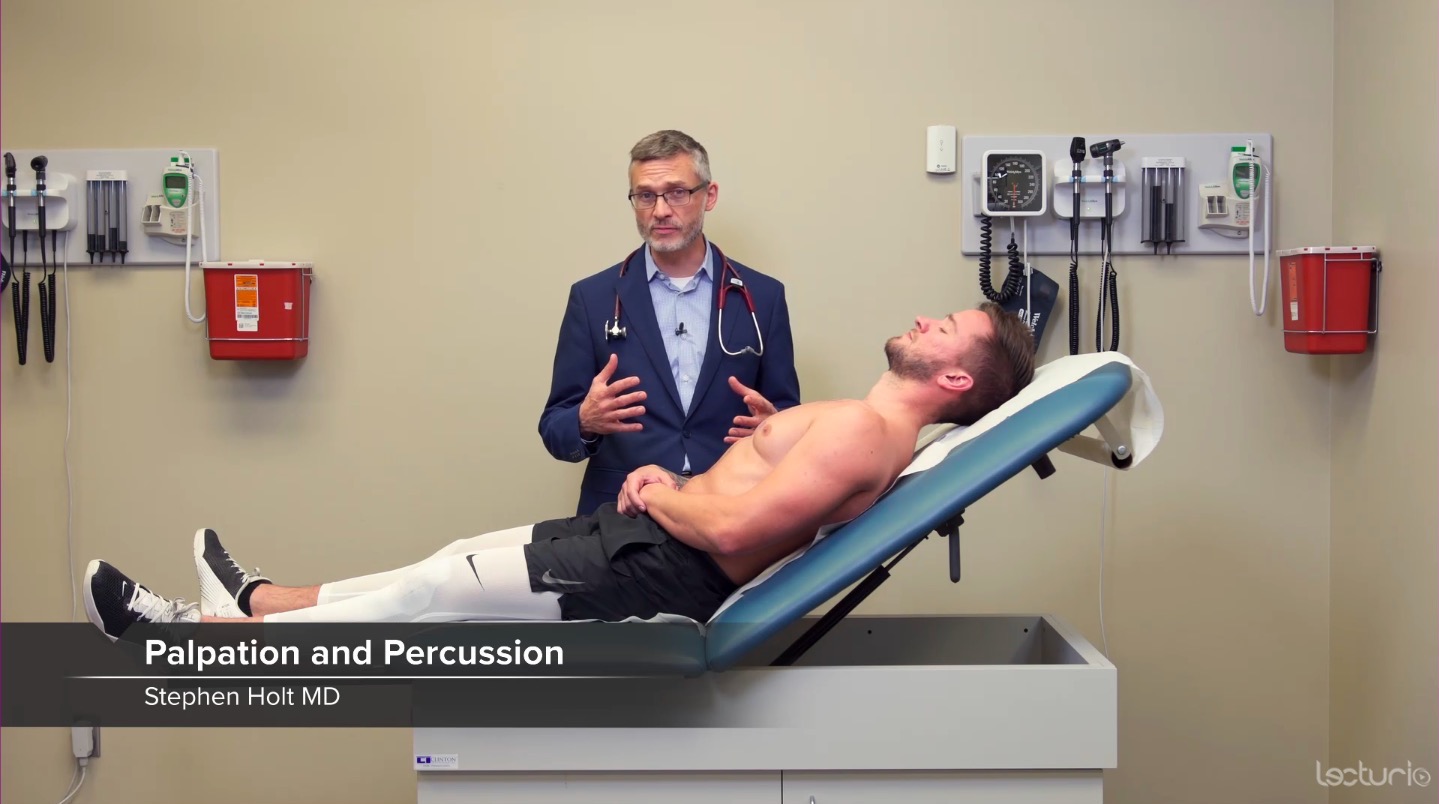Playlist
Show Playlist
Hide Playlist
JVP
00:01 miss anything else. Are you guys happy? What do you do in the full abdomen exam, does that stuff include JVP? You can do. What would you do when you examine the JVP? Position the patient to 45 degrees and turn the head to the left and get a good light source and feel the veins. 00:21 Absolutely. What’s the other thing you can do to make -- Press on the liver. Exactly! So you just make sure in that as well that you’re asking them, are you tender at all and I’m going to push in your tummy. So the salient point for an abdomen exam is make sure you’re exposing the patient appropriately. Make sure that the patient is lying flat. I remember in one exam that a friend did at different university. They had the patient at 45 degrees inclining and you had to go in and put the patient flat. The other thing is when you palpate in the abdomen, make sure that you’re on the patient’s level and you’re looking at the patient’s face. 00:54 Just be really systematic, okay? Just make it look like you’ve done it a million times before. So for shifting dullness, you start at the umbilicus? So you start at the umbilicus and you go down. 01:04 You’re trying to demonstrate. So if you imagine you’ve got fluid, it’s going to sit in the flanks. So you’re going from resonant, resonant, resonant into the fluid level. That’s where it becomes dull. So you keep your finger on that and get the patient to roll over to the side. Far away from you. 01:17 Well, yeah, they’d have to roll away from you. So if you want them to roll towards you, you percuss the other side over the patient. Roll towards you, wait for 30 seconds, and then re-percuss. So what additional information does hepatojugular reflex give you? In terms of the JVP, if you think about the blood supply going back to the heart, you have a lot of venous reserve in the liver. 01:44 So when you’re pushing on that, you’re increasing the venous return. So the idea being that you might make a JVP that’s otherwise not visible to be more prominent. 01:54 What would that be, normal or abnormal? It’s in the context of the patient. So say if you’re the patient that had a heart condition, that might not result in any rise in the JVP. 02:06 But if you’ve got a patient that’s dehydrated and you’re able to increase the venous return to the heart, you might see that that’s raised, so in dehydrated patient that would cause a rise. It shouldn’t cause a rise in a normal patient? It will do. But if someone has got an incompetent valve no matter how much blood you’re pushing back into the heart, the amount, the cardiac output is not going to be affected by whatever you effort is. 02:28 Does that make sense? I don't understand. It doesn’t make sense at all. Okay. So your cardiac output is your stroke volume. So the volume of blood that’s in your ventricle times by your heart rate. 02:42 So when you’re looking at the JVP, you’re not necessarily getting the patient’s heart to work any faster but you are trying to increase the amount of blood that’s going back in. If you’ve got an incompetent valve, so every time the ventricle beats it opens up, but it is not closing and stopping the blood from flowing back. You might get a lot of blood coming up, but it would drop very quickly. Does that make sense to you? Do you necessarily see the JVP rising in the same way? It makes sense but now it doesn’t make sense why you do it and do the reflex in the abdo exam because if you can’t see it and then you push on the abdomen and you can see it, what’s the significance of that? Is it actually raised or you’re just showing that it can be raised by you pushing on this? It can give you an idea about the patient’s fluid status. And if you think that someone has got a lot of hepatomegaly because it’s now either you got a lot of venous storage of blood. That might give you an idea that the liver is enlarged as well. It’s not directly related to an abdo exam which is why I don’t always do when I do my abdo exam. 03:42 So in a normal person, when you press on the abdomen, it wouldn’t raise as much? If you have someone that is otherwise normal, you push on the liver, the JVP will go up. 03:58 Okay. If you’ve got a patient with dehydration, you might not see the JVP to begin with and you push on the liver, it might go up a little bit, because you’re increasing that cardiac return to the heart. So you’ve got an increased volume that’s coming out of the ventricles. 04:12 If you’ve got a patient that is otherwise, what was the other question? Normal. Yeah. If a patient is otherwise normal and you do that, you will get a rise but it’s just demonstrating that perhaps if you couldn’t see it first, you are doing something to make it more prominent. I hope that makes sense. 04:32 Yeah, I understand it to be a way of making it more easy to say rather than any pathological -- It’s all in the clinical context of whatever you’re examining the patient. So don’t get too hung up about it.
About the Lecture
The lecture JVP by Noor Sash, PhD is from the course The Physical Exam (MRCS).
Customer reviews
2,2 of 5 stars
| 5 Stars |
|
0 |
| 4 Stars |
|
2 |
| 3 Stars |
|
0 |
| 2 Stars |
|
0 |
| 1 Star |
|
3 |
fair explanation but would have preferred her to do more demonstration using too
Not very well practical not understood even a single thing
It more discussion then teaching material ... would be better for me to watch youtube material
examiner won't eplain in detail about the procedure and she insits on the students to explain about the procedure, which is inaudible.





